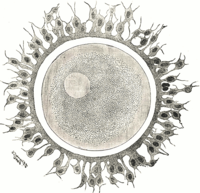
Photo from wikipedia
In flowering plants (angiosperms), fertilization of the egg cell by one sperm cell produces an embryo, whereas fusion of a second sperm cell with the central cell generates the endosperm.… Click to show full abstract
In flowering plants (angiosperms), fertilization of the egg cell by one sperm cell produces an embryo, whereas fusion of a second sperm cell with the central cell generates the endosperm. In most angiosperms like Arabidopsis, a pollen grain contains two isomorphic sperm cells required for this double fertilization process. A long-standing unsolved question is whether the two fertilization events have any preference. A tool to address this question is the usage of the cdka;1 mutant pollen, which produces a single sperm-like cell (SLC). Here, we first adopt a complementation-based fluorescence-labeling method to successfully separate and collect cdka;1 mutant pollen containing a single SLC. Single-cell RNA sequencing analysis revealed that cdka;1 SLCs show a gene expression profile highly similar to that of sperm cells and not to the generative cell, precursor of the two sperm cells. Pollination assays using a limited number of cdka;1 mutant pollen revealed that in 98.2% of the ovules, single fertilization of the egg cell occurred. Pollination of pistils with excessive cdka;1 mutant pollen allowed the delivery of a second SLC via fertilization recovery, which fertilized the central cell, resulting in 20.7% double-fertilized ovules. This indicates that cdka;1 SLCs are capable to fertilize both the egg and the central cell. Taken together, our findings have answered a long-standing question and support that preferential fertilization of the egg cell is evident in Arabidopsis. This article is protected by copyright. All rights reserved.
Journal Title: Journal of integrative plant biology
Year Published: 2022
Link to full text (if available)
Share on Social Media: Sign Up to like & get
recommendations!